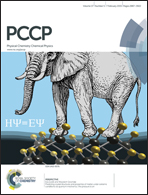Photoelectron spectroscopy and theoretical studies of anion–π interactions: binding strength and anion specificity†
Abstract
Proposed in theory and then their existence confirmed, anion–π interactions have been recognized as new and important non-covalent binding forces. Despite extensive theoretical studies, numerous crystal structural identifications, and a plethora of solution phase investigations, anion–π interaction strengths that are free from complications of condensed-phase environments have not been directly measured in the gas phase. Herein we present a joint photoelectron spectroscopic and theoretical study on this subject, in which tetraoxacalix[2]arene[2]triazine 1, an electron-deficient and cavity self-tunable macrocyclic, was used as a charge-neutral molecular host to probe its interactions with a series of anions with distinctly different shapes and charge states (spherical halides Cl−, Br−, I−, linear thiocyanate SCN−, trigonal planar nitrate NO3−, pyramidic iodate IO3−, and tetrahedral sulfate SO42−). The binding energies of the resultant gaseous 1 : 1 complexes (1·Cl−, 1·Br−, 1·I−, 1·SCN−, 1·NO3−, 1·IO3− and 1·SO42−) were directly measured experimentally, exhibiting substantial non-covalent interactions with pronounced anion-specific effects. The binding strengths of Cl−, NO3−, IO3− with 1 are found to be strongest among all singly charged anions, amounting to ca. 30 kcal mol−1, but only about 40% of that between 1 and SO42−. Quantum chemical calculations reveal that all the anions reside in the center of the cavity of 1 with an anion–π binding motif in the complexes' optimized structures, where 1 is seen to be able to self-regulate its cavity structure to accommodate anions of different geometries and three-dimensional shapes. Electron density surface and charge distribution analyses further support anion–π binding formation. The calculated binding energies of the anions and 1 nicely reproduce the experimentally estimated electron binding energy increase. This work illustrates that size-selective photoelectron spectroscopy combined with theoretical calculations represents a powerful technique to probe anion–π interactions and has potential to provide quantitative guest–host molecular binding strengths and unravel fundamental insights in specific anion recognitions.


 Please wait while we load your content...
Please wait while we load your content...